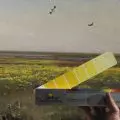The World Visualization Festival, an event aspiring to be the most important, if not the largest, gathering of visualizers in the world, will be held at the Warsaw Breweries in the fall. We talk about whether renders are "stretching" reality, what skills a good visualizer should have, and why it's worth attending the festival with its co-organizers Jakub Figel and Filip Kurasz, a duo of architects who founded the ELEMENT visualization studio in 2014.
Ola Kloc: It happens that architecture graduates choose related career paths, often setting their sights on graphics or creating visualizations precisely, how was it in your case?
Jakub Figel: We based our business initially on participation in architectural competitions, where we had some success, by the way. Quite quickly, we also managed to find work in reputable architectural offices in the Netherlands. And there, for the first time, we felt what the everyday life of the architectural profession is all about. It turned out that there was little creation and testing of concepts, and this is what had always fascinated us most in this occupation. So it so happened that we began to explore the world of 3D visualization. And there a wide field opened up for us to test, create, confirm visions. And since there was a lot of demand for such services, we had something to do. We soaked in this world more and more. Each realized render became better and better, until finally visualizations became the foundation of our business.
Visualization of Wood City in Stockholm, Sweden, designed by Henning Larsen
© ELEMENT
Filip Kurasz: Moving from creating traditional architecture to our own visualization studio was a natural step for us, stemming from our interests and needs. Positive feedback from clients only solidified our decision. On the one hand, we were very much drawn into the 3D world. We derived and still derive a lot of pleasure from what we do. From the beginning, we were also attracted by the prospect of operating on our own, creating something of our own, our own place where we could decide what criteria and values we would follow in business. And that's why ELEMENT was created.
Ola Kloc: What skills should an architectural visualization author have?
Filip Kurasz: The first thing that comes to mind is the ability to look broadly, to notice dependencies and connections, and at the same time to be sensitive to every detail. As visualizers, we approach projects more objectively, we take different perspectives, we take into account the optics of both the architect and the investor, greenery designer, interior designer. A good visualizer should also be able to draw from many inspirations. When working, we support ourselves with knowledge and interests from many fields: photography, design, art or programming.
Visualization of the IOM in Geneva, Switzerland, proj.: G8A, Localarchitecture
© ELEMENT
Ola Kloc: You do visualizations for renowned architectural studios such as Henning Larsen and Dorte Mandrup, how did your collaboration begin?
Jakub Figel: Our collaborations with foreign architectural firms and developers are a direct continuation of the relationships and contacts we established while working at Dutch studios. In retrospect, we know that the decision to emigrate temporarily and gain work experience in Amsterdam was a hit with us. Not only did we learn a certain work ethic there, looked at the best models and model approaches to architecture, but we also brought a lot of contacts from this adventure, which still help us create ELEMENT on our own terms.
Visualization of a church in Sarnen, Switzerland, proj.: Mulder Zonderland
© ELEMENT
Ola Kloc: Visualizations are sometimes judged negatively — they are associated with a false image of an idyllic life on a full green estate, where apartments on huge billboards try to sell us developers. From your perspective, what is the role of visualization in the design and marketing process of a development?
Jakub Figel: There are different approaches to this profession, which is why so many visualizations of varying, often questionable quality are observed in circulation. A large part of them are indeed "stretched" reality. But you can't blame visualizers alone for this — often the guidelines for beautifying a landscape or a project come from the developer, or other people involved in the project.
We can only speak for ourselves, about our own way of working and the criteria that guide us in it. We want to be true to our own values in this trade. Our goal is always to stay true to reality, so we avoid distorting it in any way. We know from our own experience that there are many clients who share this approach, who are not interested in falsity.
E-Pavilion in Vancouver, Canada, and a residence in Menorca, Spain
© ELEMENT
Filip Kurasz: In ELEMENT's visualizations, we always strive for maximum authenticity, but also to bring out the beauty in the design. We are big fans of architecture, so we focus on finding the perfect shots and frames that will be able to evoke some kind of emotion in the audience, create a deeper connection with the image. We know that in a world full of stimuli and distractions, our visuals can only hope for a moment's attention from the viewer. So we have to try to make it unique, stand out with something, move something in people. I think that arousing emotion is really just the main role of visualization — and certainly if we are talking about marketing. That's why I often compare renderings to the power that photography has. It is very important for us to choose the right means of expression. We have our own style, but we also look for the distinguishing features of a place. We try to capture its atmosphere, for example, through unique light.
Visualization of the interior of the Fryderyk Chopin Center in Żelazowa Wola
© ELEMENT
Ola Kloc: You are co-organizing the World Visualization Festival, who is this event aimed at, and why is it worth taking part?
Filip Kurasz: The World Visualization Festival is something we are very excited about, because we know how needed such meetings are in our industry. We have something of a sense of mission and an ambitious goal to make this event the largest, and certainly the most important gathering of visualizers in the world.
We are aiming the festival broadly — at artists and professionals working in 3D graphics and CGI (Computer Generated Imagery), as well as people who use the results of their work in their business, such as architects or advertising and marketing specialists. Our thinking about this event goes much wider than the topic of architectural visualizations, although we will be talking about them especially at the festival. WVF is also a place for technology innovators and experts in fields such as automotive, design, education or artificial intelligence. On the list of speakers we have a great group of "howlers" in the visualization world, there are also representatives of many large architectural offices, such as Cobe, Henning Larsen and MVRDV.
Jakub Figel: The festival's slogan is "Reimagine the future". We want to talk about important topics in our industry and its future. A lot of attention will be paid to trying to set new industry standards, creating business opportunities or openly discussing earnings. It is one thing to participate in panels and discussions with the best specialists in your field, but networking is also very important, which will happen during the event. This is an important element for both experienced professionals, but also for students and people who are just starting out. By the way — the first day of the festival is a workshop day, where you will be able to learn from the best names in the industry. Students can count with us on a 50% discount for participation in the entire event. Join us at the Warsaw Breweries from October 3 to 5 this year!
More information: World Visualization Festival
World Visualization Festival
© organizers archive



















































